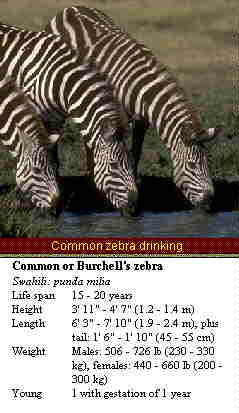 Identification - The common zebra has broad, widely spaced stripes which are generally more brown in
color in females and jet black in stallions. Boehm's zebra (Equus burchelli boehmi) of southern Kenya
and Tanzania has brown shadow stripes between the main stripes. Each zebra has a unique pattern of
stripes.
Identification - The common zebra has broad, widely spaced stripes which are generally more brown in
color in females and jet black in stallions. Boehm's zebra (Equus burchelli boehmi) of southern Kenya
and Tanzania has brown shadow stripes between the main stripes. Each zebra has a unique pattern of
stripes.
Voice - The contact call is a peculiar barking noise which sounds rather like a cross between a dog
barking and a donkey braying. Zebras snort abruptly when alarmed or nervous, and adults squeal when
threatened or bitten. Foals wail if distressed.
Habitat - Open grassy plains, wooded grasslands and semi-arid grass bush.
Habits - Diurnal and nocturnal, though generally more active during the daytime. Zebras are gregarious,
and are usually found in groups of up to six females accompanied by their offspring and a mature male
who is the dominant member of the group. Young males leave their family group at between one and three
years of age and join bachelor herds. These herds number from two to ten males (sometimes more),
consisting entirely of young or older males, or a mixture of all age groups. Seniority in these bachelor
herds is age-based. The younger males often chase one another and play-fight, testing themselves
against age-mates, though they do not begin to try and form harems of their own until they are five years
old. Members of a family herd often groom one another, facing in opposite directions so that each can
reach the other's head, neck and shoulders. Individuals often rest in this position, enabling them to keep
watch for predators. These activities help to reinforce bonds among family members. The largest herds are
a feature of the dry season when the zebras migrate long distances in their tens of thousands in search of
good grazing and water, though the individual families still remain intact.
The herd stallions are not territorial; instead they defend their harem year round irrespective of where they
happen to be. Rival males engage in ritualized fights, dropping to their knees and attempting to bite the
legs of their opponent or rearing up on their hind legs and neck-wrestling, biting at each other's face and
neck and kicking with their forelegs. A zebra will lash out with its hind legs if pursued too closely, an
effective way of deterring further conflict. Zebras usually commute between the long grass areas where
they feed during the daytime, and sleep in areas among shorter grass where they are safest from
predators. They continue to graze during the night and sleep intermittently, but at least one of the family
remains alert and on its feet. Zebras regularly dust bathe by rolling on their backs, an activity that helps to
keep their coat in good condition, and may reflect sunlight and keep them cool. Zebras are capable of
galloping at speeds of up to 40 mph (65 kmh) when pursued by predators.
Reproduction - Stallions acquire females by abducting young mares from another family. This happens at
the onset of a female's first estrus, when she is one to two years old. These young females adopt a very
obvious and distinctive stance when they come into estrus, standing with their legs apart and their tail
lifted. Competition is intense for females and a dozen or more stallions fight for possession of young
mares, making it almost impossible for the harem male to withstand their challenge. Older females conceal
estrus, and only adopt this stance when about to mate with the harem male. Females give birth in the
vicinity of their family group, and foals can stand within 10 to 15 minutes and walk shortly afterwards.
They can run within the hour.
Food - Zebras are grazers, but do not ruminate. They rely on large quantities of coarser vegetation which
they are able to process rapidly. They are highly adaptable, selecting the seed head and stem of the
longer grasses during the dry season, and feeding on short green grass during the rains. Zebras prefer to
drink daily, often making their way to water during the middle of the day.
Predation - Lions, hyenas and hunting dogs are all capable of killing both adult and young zebras, while
leopards and cheetahs take foals. When threatened, a zebra family bunches together and moves off with
the stallion bringing up the rear. This is often sufficient to deter a full-fledged attack by pack hunting
hyenas and wild dogs. If not, adult zebras are capable of delivering a bone crushing kick, and have been
known to smash the jaw of a pursuing predator. Added to this, their teeth are razor sharp and can snap a
man's arm.
|





